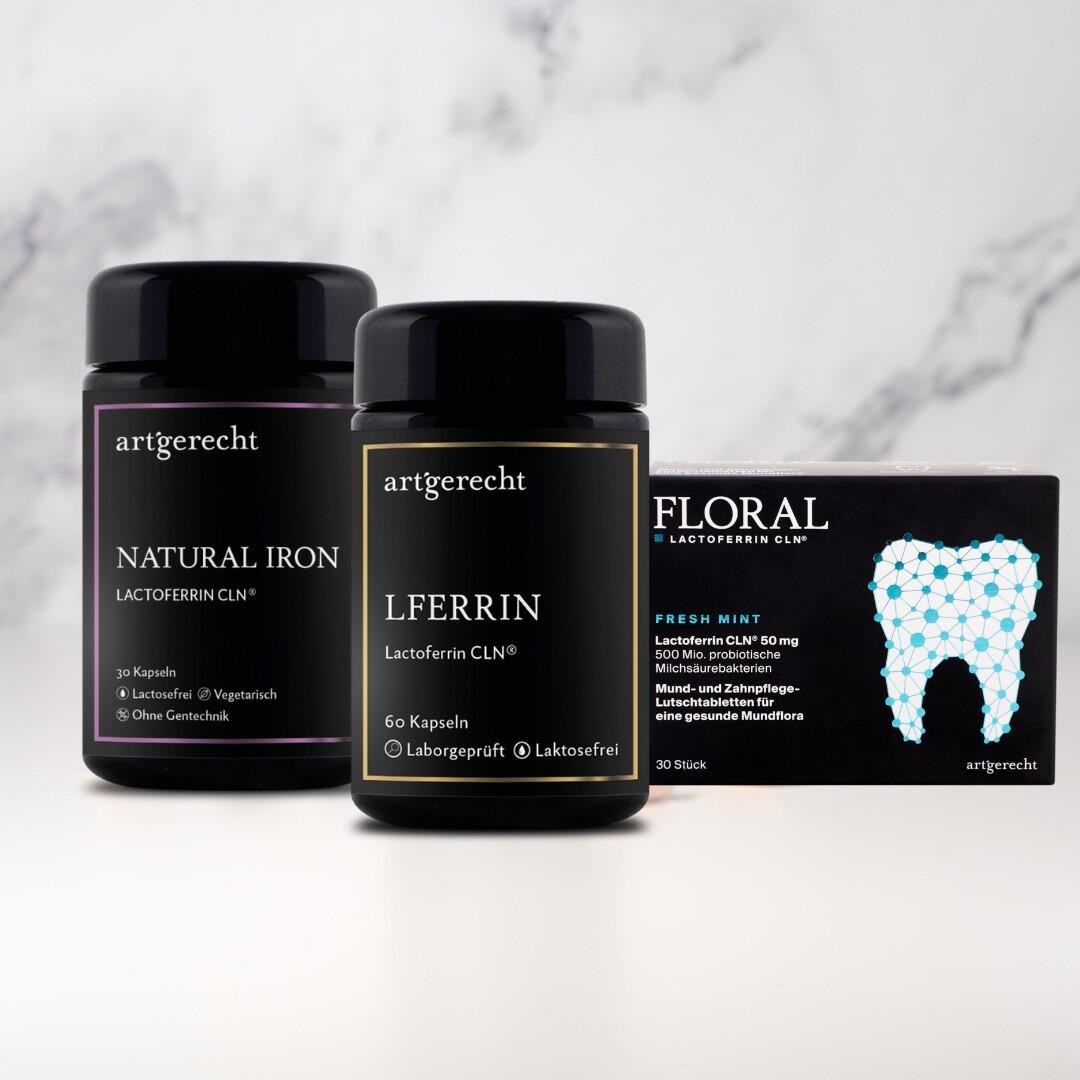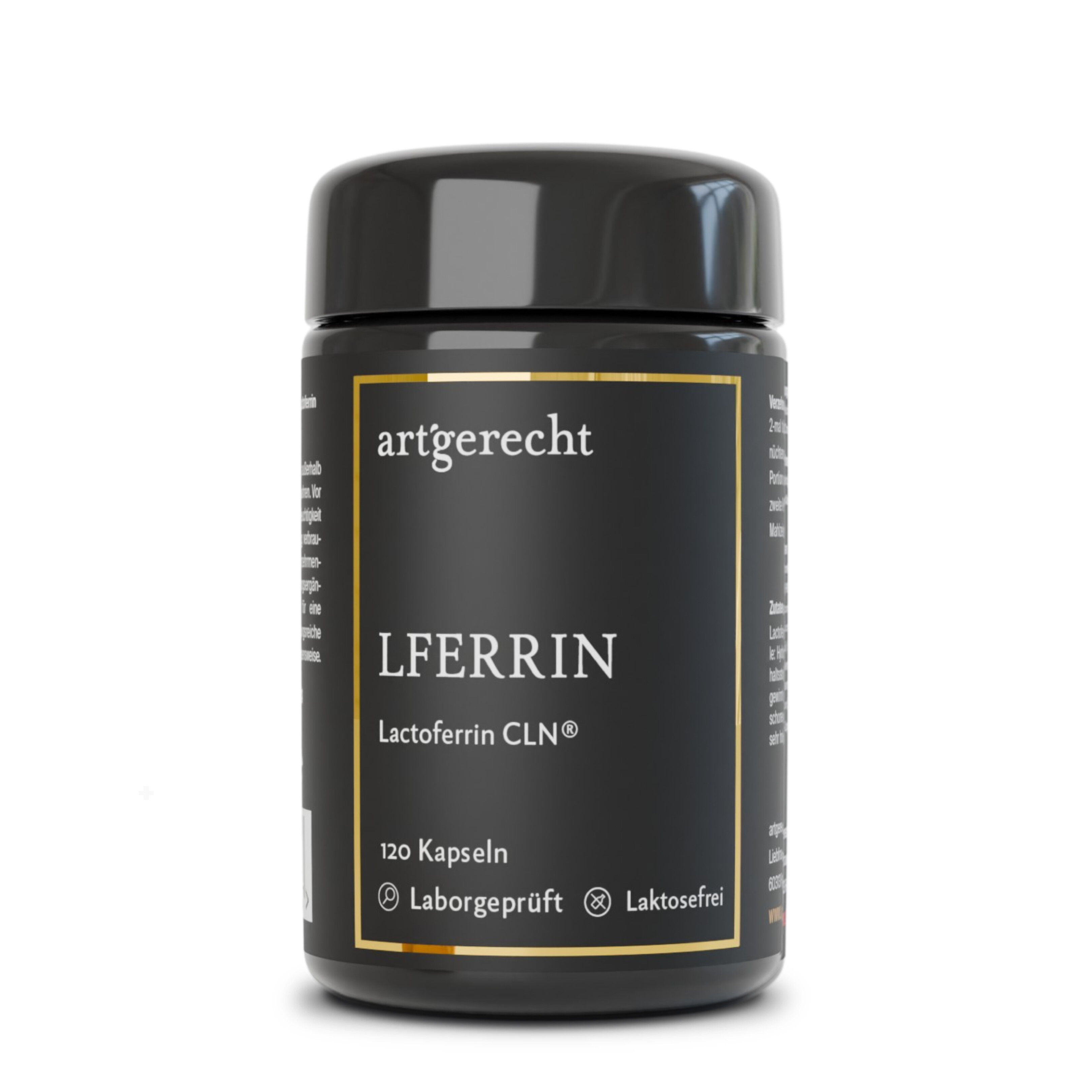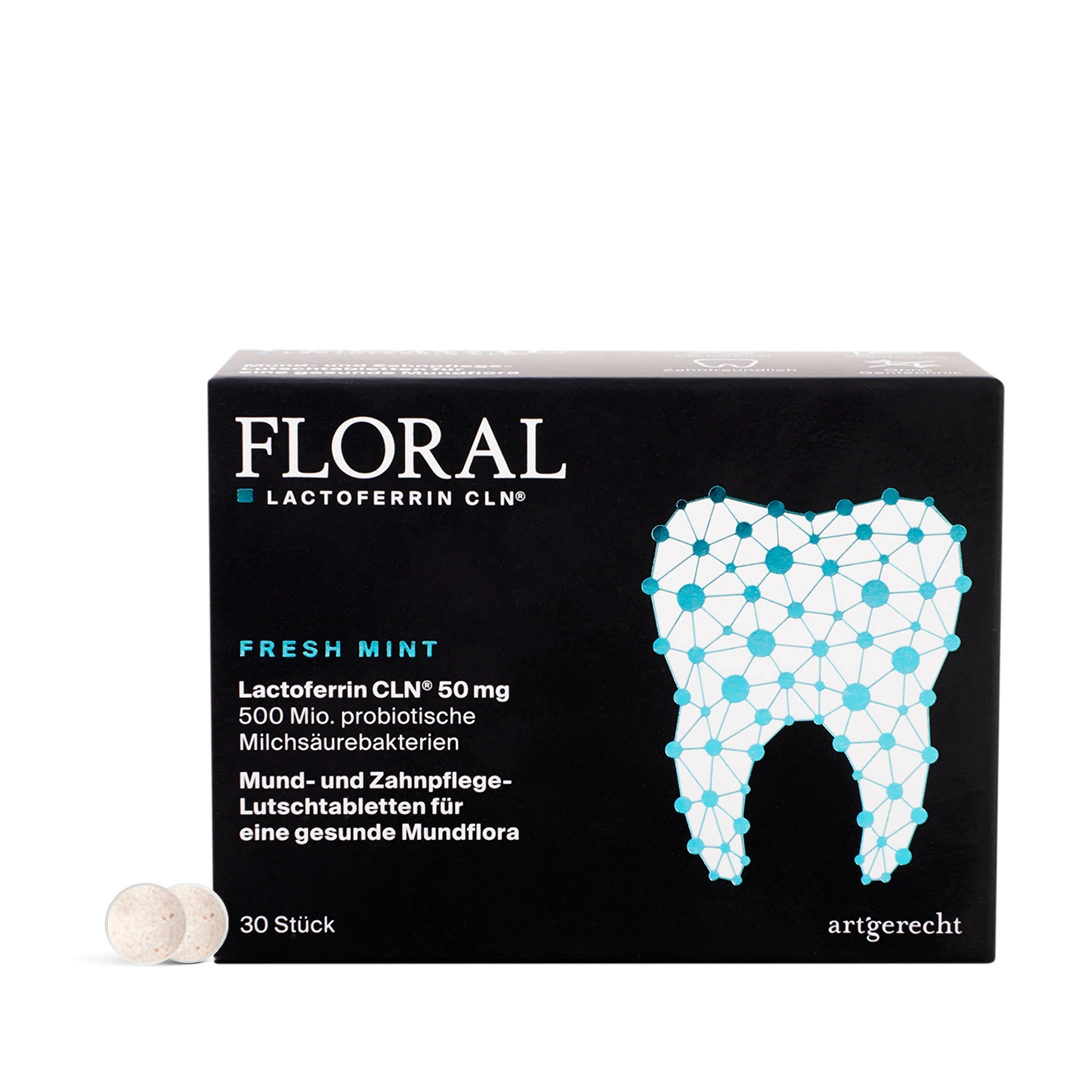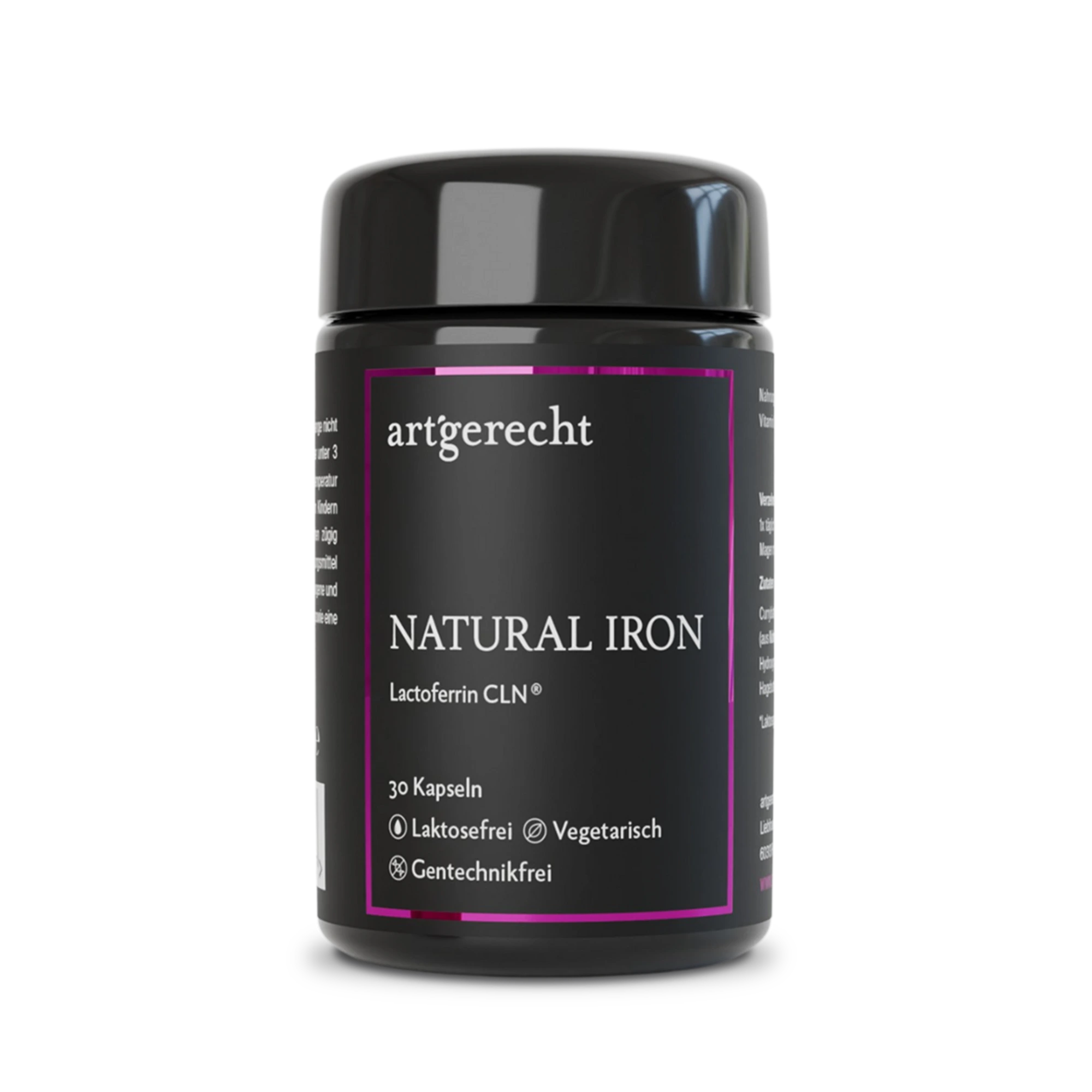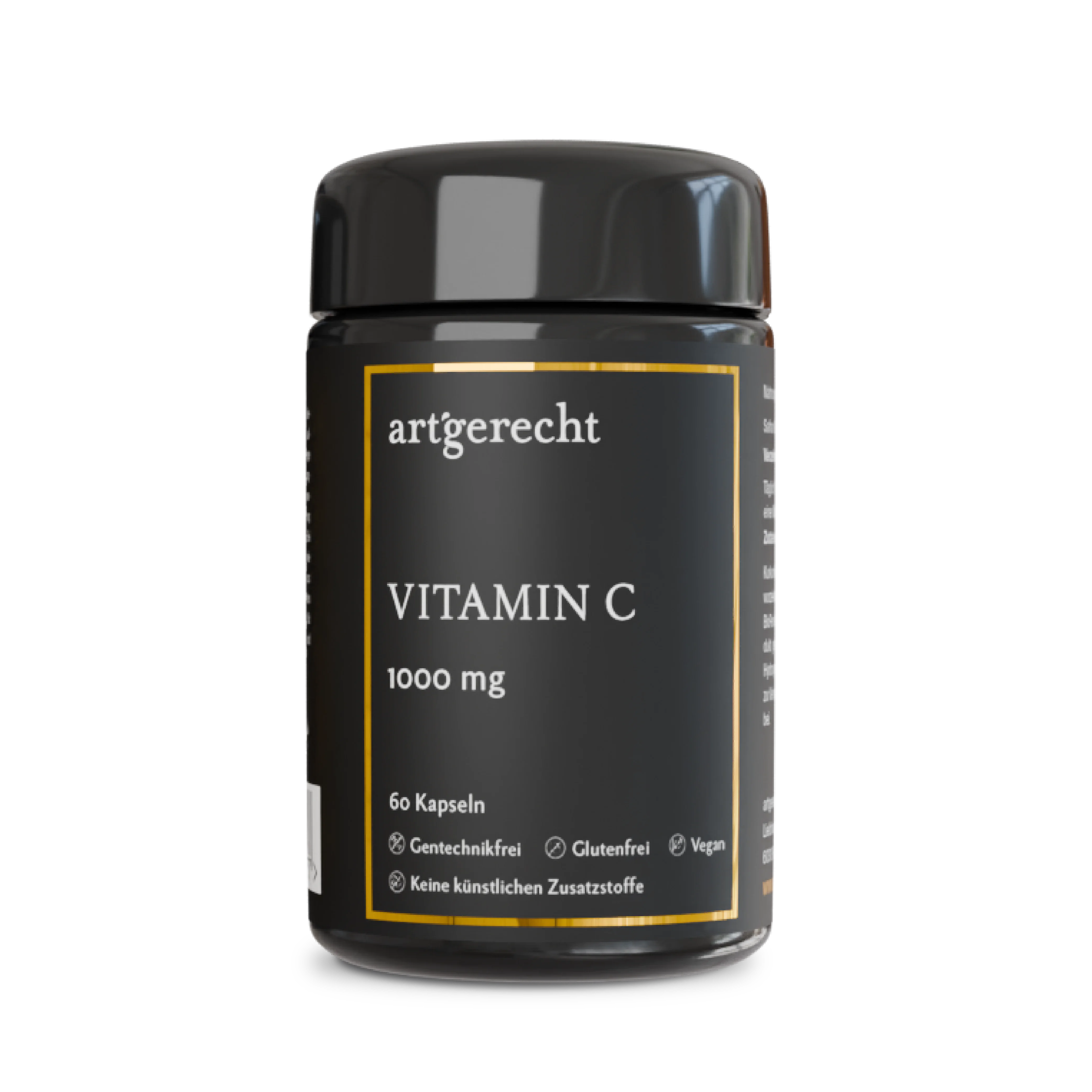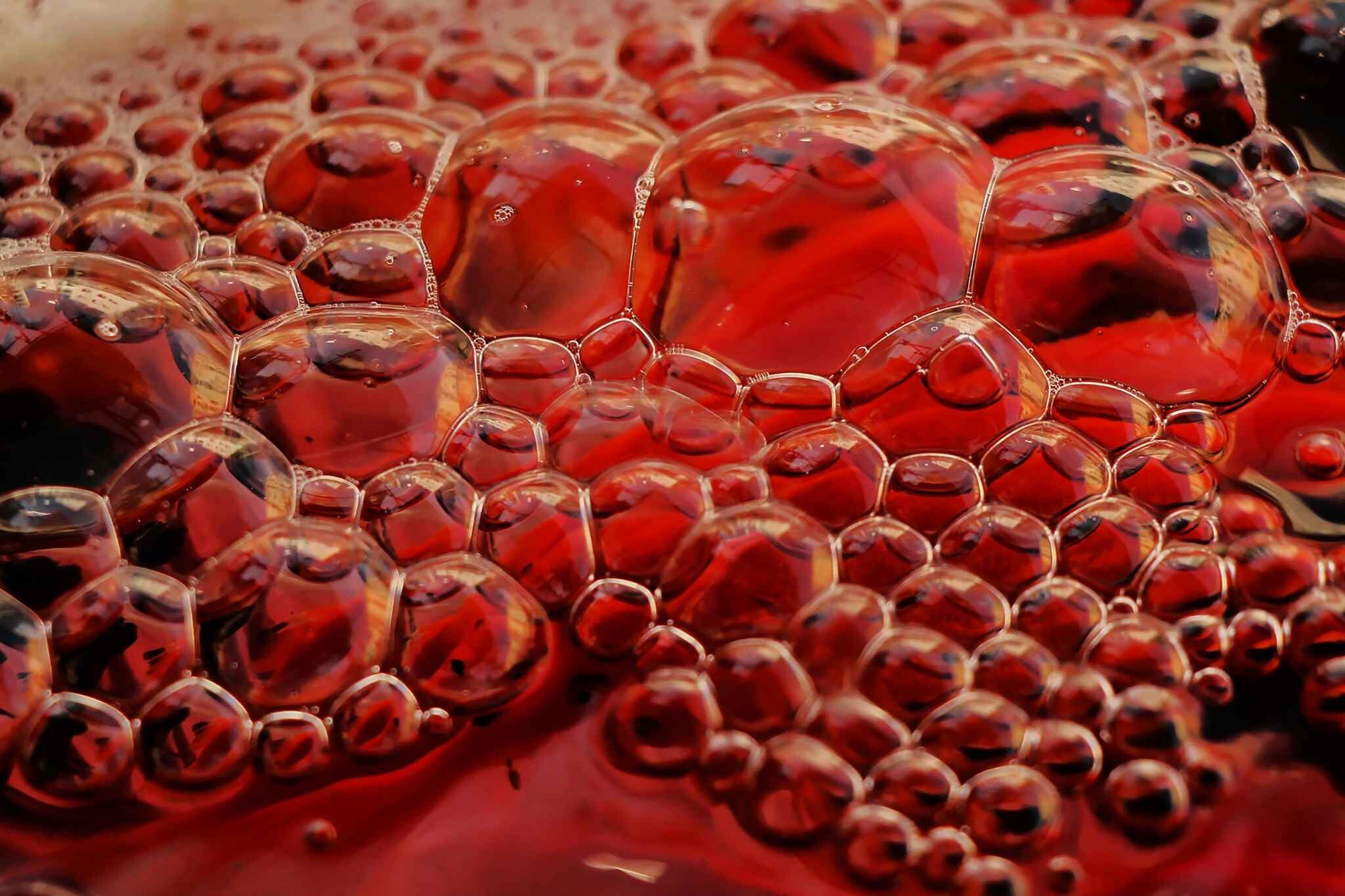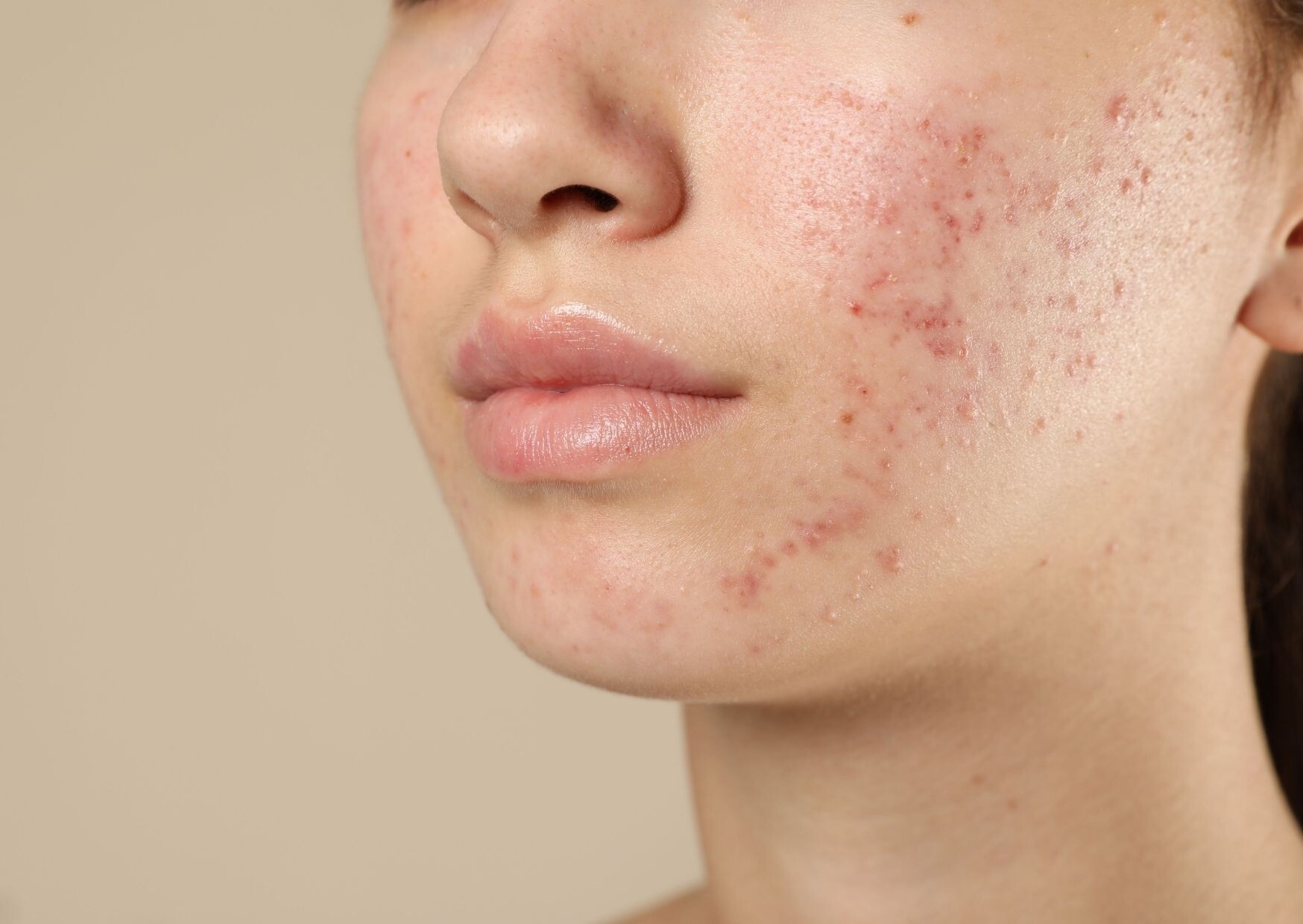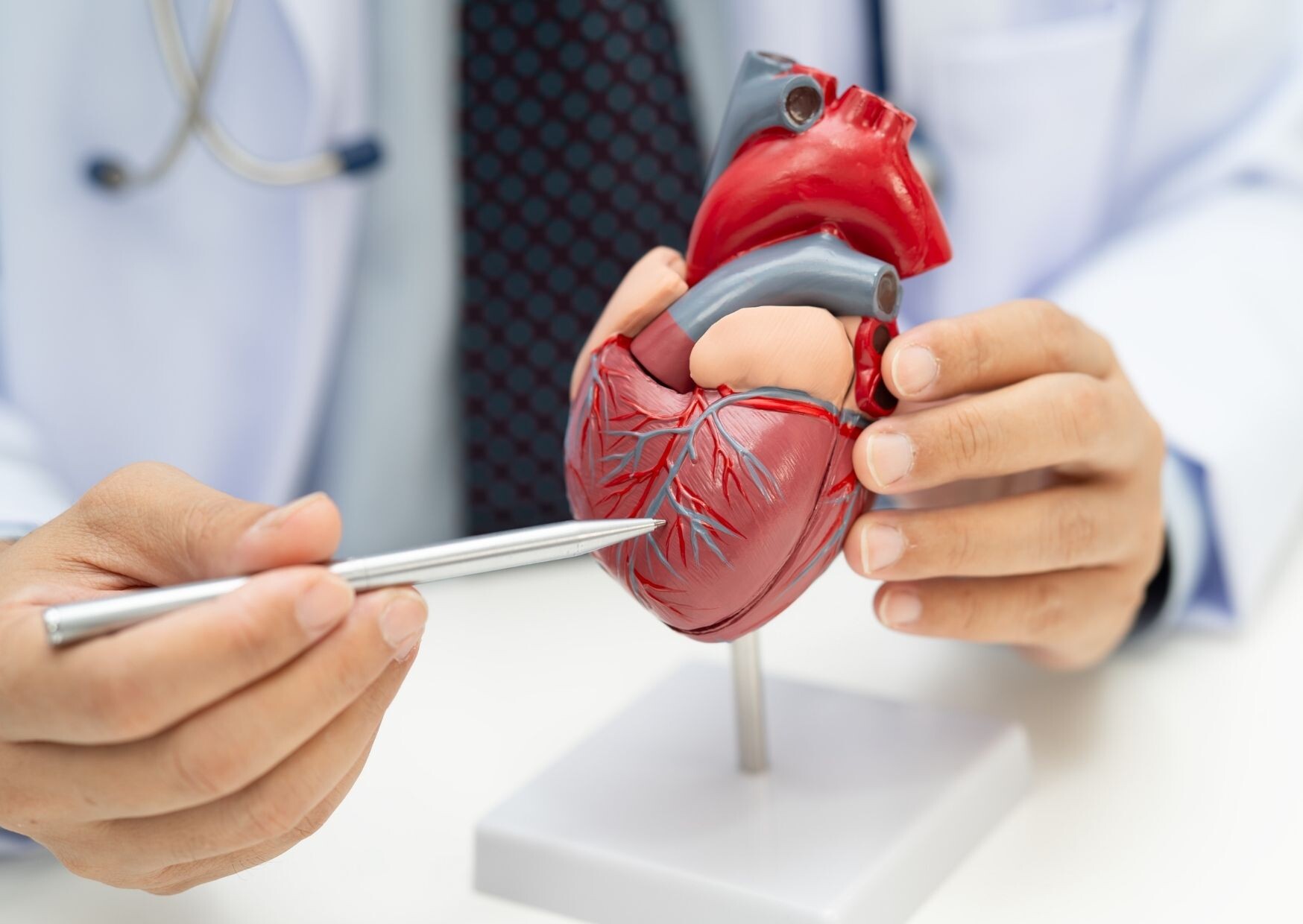Lactoferrin is a naturally occurring glycoprotein that is mainly found in immune-boosting breast milk and colostrum. It is also found in numerous bodily secretions, mucous membranes and neutrophil granulocytes (immune cells). Lactoferrin is being studied for various potential health benefits, including its role in the regulation of iron balance, dental health and many other different areas.
Lactoferrin in the iron balance:
Iron is an essential element for cell growth and proliferation and is essential for DNA replication processes and energy production. However, it can also be toxic when present in excess, as it can donate electrons to oxygen, leading to the formation of reactive oxygen species (ROS). These can then cause tissue injury and organ damage by damaging a number of cellular components, including DNA, proteins and membrane lipids. Under normal circumstances, there are no significant concentrations of free iron, as iron is virtually always present in complexed and/or protein-bound form. In contrast to other minerals, the delicate balance between iron absorption and toxicity is maintained by systemic control mechanisms. Iron deficiency anaemia is the most common and most effectively treatable form of anaemia worldwide and its causes include pregnancy, blood loss, kidney disease, heavy menstrual bleeding, inflammatory bowel disease, bariatric surgery or very rare genetic disorders. The usual intervention for iron deficiency consists of iron substitution, primarily with the oral administration of ferrous sulphate. Multiple undesirable side effects can occur during therapy, such as nausea, abdominal pain, diarrhea, constipation and black stools. Taking iron supplements can also have an effect on the intestinal microbiome. Lactoferrin has a molecular structure that offers various binding possibilities for different cell types and specific receptors. It belongs to the group of transferrins and is able to bind iron. In doing so, it supports the body in maintaining iron homeostasis. Lactoferrin has already been shown in multiple studies to be a promising approach in the treatment of iron deficiency anaemia 4,,.
A purely herbal product to support the iron balance is NATURAL IRON from artgerecht. The unique combination of highly purified lactoferrin CLN®, plant-based curry leaf iron and vitamin C from rosehip extract can support the daily intake of iron. Women in particular, especially during pregnancy, as well as athletes and vegetarians, can benefit from this selected combination.
Lactoferrin in dental health:
The oral microbiome can influence the balance between health and disease both locally and throughout the body. Bacteria, archaea, fungi, protozoa and viruses are found in the oral cavity, each performing specific functions while interacting intensively with each other and the host - in both healthy and diseased states. The oral microbiome changes dynamically in the course of life. Oral diseases of microbial origin are often caused by a reduction or imbalance in the diversity of the microbiome. The bacteria mentioned above are the main causes of the two most common oral bacterial diseases in humans: Dental caries and periodontitis. Although both diseases are clearly bacterial in origin, they are not considered classical infectious diseases as they result from a complex interplay between the microbiome, host susceptibility and environmental factors such as diet and smoking. A dysbiotic microbiome, led by Streptococcus mutans, leads to the production of various acids, especially lactic acid, which partially demineralize the tooth surface. This mineral loss increases the porosity of the enamel, which widens the spaces between the enamel crystals and softens the surface, making it easier for the acids to penetrate into the deeper layers of the tooth. This results in further demineralization under the surface, which leads to the development of tooth decay. Once the enamel is damaged, pathogenic bacteria can invade the dentin and pulp and cause pulpitis (inflammation of the central vascular and nerve bundle of the tooth). With regard to oral pathologies, lactoferrin has been shown to play a protective role against dry mouth, gingivitis and periodontitis due to its antibacterial and anti-inflammatory properties. In contrast to antibiotics, which are often less effective against bacteria in biofilms or intracellular environments, the local application of lactoferrin has been shown to be effective. Lactoferrin is simultaneously effective against microbial proliferation, biofilms, adhesion and invasiveness as well as inflammation in the oral cavity, making it a treatment option against oral pathologies - without any side effects 2.
This is where FLORAL comes in: a premium combination of Dentalac with specific probiotic Lactobacillus strains and Lactoferrin CLN® . FLORAL can enhance dental and oral care by promoting healthy and balanced oral flora and preventing bacterial imbalance. One lozenge contains 50 mg of lactoferrin and 500 million probiotic lactic acid bacteria. Lactoferrin promotes the growth of „good“ lactic acid bacteria and thus supports the suppression of harmful bacteria. This promotes the healthy balance of the oral flora, which contributes to the care of the mouth and teeth and can protect against tooth decay, gingivitis and periodontitis.
In addition, lactoferrin as such can support the body in various areas:
Influence on the microbiome:
Lactoferrin can have a positive influence on the vaginal microbiome, for example, by reducing the number of pathogenic germs and simultaneously increasing the concentration of lactobacilli. Lactoferrin can also have a positive effect on the oral microbiome as described above. Here, the use of lactoferrin was shown to be protective against the development of dental caries and could also play a protective role in other oral pathologies such as dry mouth, gingivitis and periodontitis ,2.
Immune defense:
Lactoferrin has an antiviral effect against a large number of both pathogenic and non-pathogenic viruses. Particularly in the acute phase of a viral infection, it inhibits the penetration of virus particles into the host cell, either by binding directly to the virus particles or by blocking their cellular receptors.
Metabolic diseases:
With its multiple functions, lactoferrin also has an influence on individual components of the metabolic syndrome, such as the regulation of carbohydrate and fat metabolism. For example, lactoferrin could have a positive influence on the development of insulin resistance and high blood pressure. In addition, its influence on the growth of adipocytes (fat cells), inflammatory processes and other endocrine factors is also being discussed.
Neuroprotection:
There is preclinical evidence that the administration of lactoferrin during pregnancy can also modulate the consequences of inflammation on the brain development of the foetus and could therefore have a neuroprotective effect against early damage. Lactoferrin could also have a neuroprotective function in the adult brain. The passage of lactoferrin into the brain occurs specifically from the blood via the blood-brain barrier through dynamic lactoferrin receptors, which are mainly expressed in endothelial cells of the brain. There it could support the brain's cognition and prevent the development of neuropsychiatric diseases 18,.
Cardiovascular diseases:
Many diseases, such as stroke, high blood pressure, heart failure, venous disease and coronary heart disease, which can lead to a heart attack, can be traced back to atherosclerosis. It has already been shown that bovine lactoferrin can increase the ""good"" cholesterol (the HDL level) in blood plasma and at the same time reduce the level of ""bad"" cholesterol (the LDL level) as well as non-esterified fatty acids and hepatic cholesterol. These and other lactoferrin-mediated mechanisms may play a role in protecting against atherosclerosis1.
Lactoferrin has the potential to be used in many different areas due to its various positive effects. It is also the subject of current studies with many interesting approaches.
The Lactoferrin CLN® from artgerecht has a very high lactoferrin content in the highest purity (97%+) to ensure maximum bioavailability and efficacy. It is produced in Germany using a gentle and complex extraction and purification process. Each capsule contains a full 200 mg of lactoferrin from cow's milk. The stomach-stable capsules transport lactoferrin LFERRIN CLN® to the center of our immune system, the intestine. From there, it can support the body in many ways.
¹ Chen, C., Lu, M., Zhang, Z. & Qin, L. The role of lactoferrin in atherosclerosis. BioMetals Preprint at https://doi.org/10.1007/s10534-022-00441-1 (2022).
² Rosa L, Lepanto MS, Cutone A, et al. Lactoferrin and oral pathologies: a therapeutic treatment. Biochem Cell Biol. 2021;99(1):81-90. doi:10.1139/bcb-2020-0052
³ Kowalczyk P, Kaczyńska K, Kleczkowska P, Bukowska-Ośko I, Kramkowski K, Sulejczak D. The Lactoferrin Phenomenon-A Miracle Molecule. Molecules. 2022 May 4;27(9):2941. doi: 10.3390/molecules27092941. PMID: 35566292; PMCID: PMC9104648.
⁴ Rosa L, Cutone A, Lepanto MS, Paesano R, Valenti P. Lactoferrin: A Natural Glycoprotein Involved in Iron and Inflammatory Homeostasis. Int J Mol Sci. 2017;18(9):1985. published 2017 Sep 15. doi:10.3390/ijms18091985
⁵ Roth-Walter F. Iron-Deficiency in Atopic Diseases: Innate Immune Priming by Allergens and Siderophores. Front Allergy. 2022 May 10;3:859922. doi: 10.3389/falgy.2022.859922. PMID: 35769558; PMCID: PMC9234869.
⁶ Wessling-Resnick M. Iron homeostasis and the inflammatory response. Annu Rev Nutr. 2010 Aug 21;30:105-22. doi: 10.1146/annurev.nutr.012809.104804. PMID: 20420524; PMCID: PMC3108097.
⁷ Elstrott B, Khan L, Olson S, Raghunathan V, DeLoughery T, Shatzel JJ. The role of iron repletion in adult iron deficiency anemia and other diseases. Eur J Haematol. 2020 Mar;104(3):153-161. doi: 10.1111/ejh.13345. Epub 2019 Dec 26. PMID: 31715055; PMCID: PMC7031048.
⁸ Anderson GJ, Frazer DM. Current understanding of iron homeostasis. Am J Clin Nutr. 2017;106(Suppl 6):1559S-1566S. doi:10.3945/ajcn.117.155804
⁹ Lepanto MS, Rosa L, Cutone A, Conte MP, Paesano R, Valenti P. Efficacy of Lactoferrin Oral Administration in the Treatment of Anemia and Anemia of Inflammation in Pregnant and Non-pregnant Women: An Interventional Study. Front Immunol. 2018 Sep 21;9:2123. doi: 10.3389/fimmu.2018.02123. PMID: 30298070; PMCID: PMC6160582.
¹⁰ Paesano R, Torcia F, Berlutti F, et al. Oral administration of lactoferrin increases hemoglobin and total serum iron in pregnant women. Biochem Cell Biol. 2006;84(3):377-380. doi:10.1139/o06-040
¹¹ Sampaio-Maia B, Caldas IM, Pereira ML, Pérez-Mongiovi D, Araujo R. The Oral Microbiome in Health and Its Implication in Oral and Systemic Diseases. Adv Appl Microbiol. 2016;97:171-210. doi:10.1016/bs.aambs.2016.08.002
¹² Wade, W. G. (2013). The oral microbiome in health and disease. Pharmacological research, 69(1), 137-143.
¹³ Radaic, A., & Kapila, Y. L. (2021). The oralome and its dysbiosis: New insights into oral microbiome-host interactions. Computational and structural biotechnology journal, 19, 1335-1360.
¹⁴ Pino A, Giunta G, Randazzo CL, Caruso S, Caggia C, Cianci A. Bacterial biota of women with bacterial vaginosis treated with lactoferrin: an open prospective randomized trial. Microb Ecol Health Dis. 2017;28(1):1357417. Published 2017 Jan 1. doi:10.1080/16512235.2017.1357417
¹⁵ Velusamy SK, Markowitz K, Fine DH, Velliyagounder K. Human lactoferrin protects against Streptococcus mutans-induced caries in mice. Oral Dis. 2016;22(2):148-154. doi:10.1111/odi.12401
¹⁶ Redwan EM, Uversky VN, El-Fakharany EM, Al-Mehdar H. Potential lactoferrin activity against pathogenic viruses. C R Biol. 2014 Oct;337(10):581-95. doi: 10.1016/j.crvi.2014.08.003. Epub 2014 Sep 22. PMID: 25282173.
¹⁷ Elizarova A. Y., Kostevich V. A., Voynova I. V., Sokolov A. V. Lactoferrin as a promising remedy for metabolic syndrome therapy: from molecular mechanisms to clinical trials. Medical academic journal 2019; 19: 46–64.
¹⁸ Schirmbeck, G. H., Sizonenko, S. & Sanches, E. F. Neuroprotective Role of Lactoferrin during Early Brain Development and Injury through Lifespan. Nutrients vol. 14 Preprint at https://doi.org/10.3390/nu14142923 (2022).
¹⁹ Mohamed, W. A., Salama, R. M. & Schaalan, M. F. A pilot study on the effect of lactoferrin on Alzheimers disease pathological sequelae: Impact of the p-Akt/PTEN pathway. Biomedicine and Pharmacotherapy 111, 714–723 (2019).
²⁰ Frostegård, J. Immunity, atherosclerosis and cardiovascular disease. BMC Medicine vol. 11 Preprint at https://doi.org/10.1186/1741-7015-11-117 (2013).
²¹ Takeuchi, T., Shimizu, H., Ando, K. & Harada, E. Bovine lactoferrin reduces plasma triacylglycerol and NEFA accompanied by decreased hepatic cholesterol and triacylglycerol contents in rodents. British Journal of Nutrition91, 533–538 (2004).
²² Wakabayashi, H., Yamauchi, K., & Takase, M. (2006). Lactoferrin research, technology and applications. International Dairy Journal, 16(11), 1241-1251.

